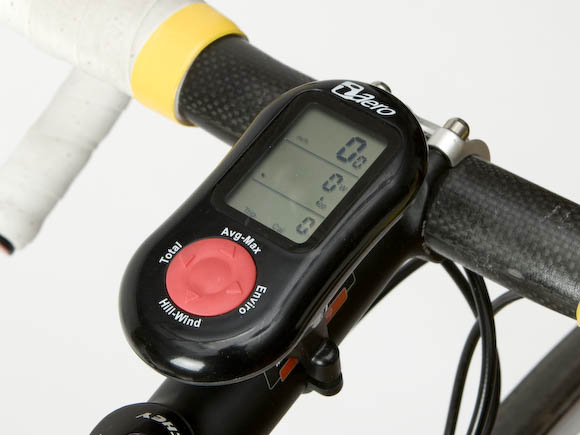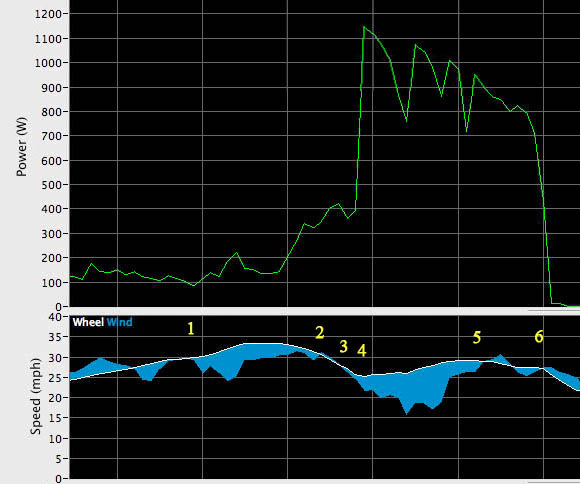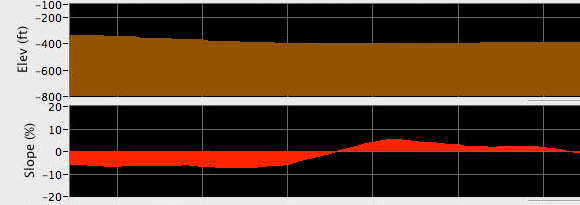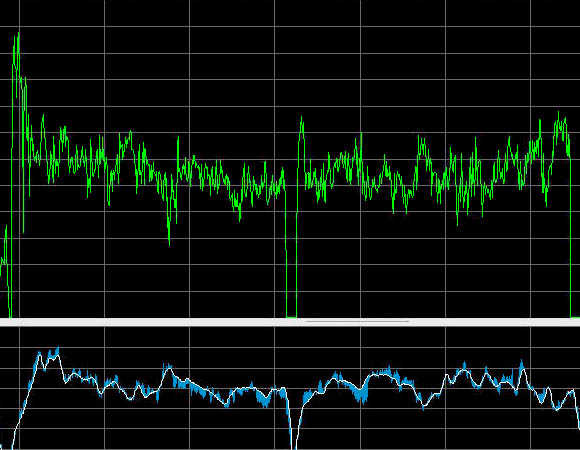Andy
I’m in the midst of a very long term test of the new Gen III iBike Aero, but given my penchant for wordiness, I thought it’d be best to break it up into a few segments lest the review reach Tolstoyean proportions. So here’s a quick intro with some preliminary findings.

The iBike is a nifty little power meter that quantifies the rider’s output by measuring all the forces that oppose forward movement with an array of sensors. A pressure port and and barometer measure wind speed, an accelerometer measures acceleration and road grade, and speed and cadence are picked up by ANT+ wireless sensors. Total weight is inputted by the rider, and CdA and Crr are determined by a series of coastdowns and a 4 mile out and back calibration ride. New to the Gen III system is a vastly improved application, improved tilt measurement, and most exciting of all, the ability to overlay the iBike file with numbers from another power meter, either on the fly with ANT+ compatibility, or after the ride in the application.
I found it difficult to do a calibration with the iBike this winter, at least one good enough to base a review on. You need a relatively still day to create a good profile, and winds have been high all winter. And with the huge variations in temperature, I found myself wearing vastly different clothes from day to day, thus altering my CdA and throwing off the numbers. So instead of using the iBike as a stand alone power meter I plowed ahead and used it in a couple of different ways.
On the Road Bike
I used the iBike as the computer head for a Quarq Cinqo, which, thanks to ANT+ can pair with a Garmin or an iBike (the iBike can serve as the computer head for ANT+ SRM’s and Powertaps too). Once paired up the Quarq sends power and cadence numbers to the iBike, overriding the iBike’s own power measurements on the display. The iBike’s own calculations, however, are still being made, and can be pulled up later in the app once the file is uploaded. Thanks to the iBike’s wind measurements, you can get some really neat race data. The second graph in the screen grab below is a comparison between ground speed and wind speed. When the blue area is below the white line you either have a tailwind or you’re in a draft. When it’s above the white line you have a headwind.

This was a short lived escape where I followed a rider off the front (the 800 watt spike in the beginning). Once away you can see where we trade pulls from looking at the notches in the wind graph. Note how the power spikes correspond to my pulls.
Here’s a state line sprint on a training ride which illustrates the level of detail you can get from an iBike file. I’m in the draft from 1 to 2, but am forced to the front from 2 to 3. I soft pedal and fake a jump from 3 to 4, resulting in a drop in speed, which coincides with the road turning up, as you can see in the slope graph at the bottom. The other guy jumps at 4, and I get on his wheel from 4 to 5, finally coming around from 5 to 6.


Time Trialing
I have a wired SRM on the TT bike, so I have to use both computers on the bike and upload the files separately. Once uploaded the iBike app uses speed data to match up the two files perfectly and merges the SRM’s power numbers over the iBike file. Once imported the composite file is just like any other file, with the SRM data embedded and saved.
Using the iBike on a TT bike used to be problematic, since arm placement in the aerobars interferes with the iBike’s pressure port. The iBike people started playing around with a hose to move the intake to a spot with a cleaner look at the wind. They thought about making a mount to hold the intake under the aerobars, but I suggested routing the hose to a handgrip. So for full disclosure purposes, I have an emotional stake in this setup, but not a financial one. The ‘Remote Wind Sensor’ consists of a plug that fits into the iBike’s pressure port, a hose, and an intake cup. It should be available in 2-3 weeks, and will work with all versions of the iBike.
I’ve been testing a prototype of the remote sensor of the last couple of weeks. The file here is from the Readington Time Trial on 4/11, a cold and rainy 8.8k. Now, remember how each ride file contains two sets of power data: the iBike calculations and the SRM data? The cool thing about the iBike app is that you can tweak your CdA and Crr numbers after the fact, which then alters the iBike’s power numbers. I inputted .0048 for Crr (a guess taken from this table) and played around with the CdA until the iBike’s average watts matched the SRM’s average watts. The CdA I got was .24, exactly the same number measured at the CCNS wind tunnel.

Give it to me in broad strokes, kid
Ok, so brevity escaped me again. Here’s the quick version. If you’re running an ANT+ power meter like the Quarq, you’ll need a computer head. Why not get one that gives you valuable race data? As for time trialing, it looks like there’s a good chance that the iBike can be a mobile wind tunnel. But there’ll be many many more experiments to do before I can say that definitively.
Â

“I found it difficult to do a calibration with the iBike this winter”
Are you saying it is pretty usless as a power meter? Is it that hard to calibrate?
I’m saying I wouldn’t do a review based on an imperfect calibration. The iBike numbers matched up pretty well in general on the road bike, but I don’t want to make conclusions unless I’m satisfied I was completely fair.
wow, fancy schmancy photos w/”pro” looking white background–looks nice!
do you have to have that goofy tube & funnel-like thing sticking somewhere on the bike to capture air for the computer to process?
Any word on whether Quark is going to go ahead with development of the Cinqo?
Dearest 12:03, read the copy. I’ll ask Mieke Meyer about the Cinqo, but I’m guessing there hasn’t been much progress. I bet they’re real busy with Cervelo test team.
Ummm…Quarq is actively selling CinQos (on their second generation now actually, the CinQo Saturn) and have been for quite awhile.
Also, why didn’t you put another GXP BB on the TT bike and just swap the CinQo over? That’s what I do…takes about 3 minutes max and only involves one bolt.
Meant “qranium” or whatever the head unit is called. Sorry – me idot.
are you going to review them next?
ahh, thanks. i actually skipped that 2nd paragraph under the TT section where you appropriately explain it…sorry.
love,
12:03.
Oh, I thought the question was about the Qranium. Sorry.
I have an Sram Quarq, BB incompatible with Shimano SRM. So the swap takes a bit more time. I’m going to eBay the SRM and get another Quarq, and I’ll probably come out $1000 ahead.
This question was on slowtwitch:
So the users iBike data didn’t match the SRM and he tweaked it after the fact to get better numbers. What if you don’t have an SRM and are using the “iBike out of the box”
I didn’t do a proper calibration with the iBike and the TT bike, so that’s probably why the numbers didn’t match.
Revolution wheels are nice so far, need to thrash them more before review.
Or is that “goofy tube” attached with a Livestrong wristband?
Why do you need another CinQo? You only ride one bike at a time right? Just “pre-install” another GXP BB on the TT bike and swap the whole crank back and forth. You loosen one bolt, pull the left crankarm off, and then pull the rest of the crankset off as one piece. Go to the other bike and reverse the process. Like I said, 3 minutes max…and that’s if you take your time
There…I just saved you $1500
but andy rides two bikes at a time when testing, so he can feel the differences in vertical stiffness and lateral compliance in real time. SCIENCE!
Spreadsheets and biking go so well together…NOT.
they’d like their “…NOT!” back
does it come with a flux capacitor?
Who will win it??
the Spring Series TT is the real question!
Is anyone doing the spring series TT? Serious format change or flat out cancelation still lead the early money betting.
TT Vegan gonna take it.
Flux capacitor? Whatever would we do with that?
https://nyvelocity.com/content/toto/2008/toto-turns-85
Had anyone ever died in a TT from injuries not sustained by a collision with a motor vehicle?
What ever happened to this site. Its all n00bs, all new people.
A little google will probably find you why CRCA doesn’t run TTs in central park anymore.
Check back on monday
Toto 85: frickin’ hilarious!
re: the Qranium
“It’s on the back burner for now and not expected to be out anytime soon. We’re focusing on getting the rest of the road CinQos out (Specialized, Cannondale, compacts, etc).”
http://www.cyclingnews.com/news.php?id=news/2009/apr09/apr17news3
Hey Bike Snob readers, read about Snob’s lunch date here: http://velocitynation.com/content/interviews/2009/michael-ashenden
“I have a wired SRM on the TT bike, so I have to use both computers on the bike and upload the files separately. Once uploaded the iBike app uses speed data to match up the two files perfectly and merges the SRM’s power numbers over the iBike file. Once imported the composite file is just like any other file, with the SRM data embedded and saved.”
So if you didnt have another power meter recording on the bike (Srm) would the number have matched those power numbers which the ibike changed after uploading, using the SRM power data as a reference point to ‘fix’ the ibike data on the pc readout graph. Although you make it sound like a great trick, isnt it pretty pointless to have that functionality as it requires an SRM, which is supposed to be replaced by the ibike :confused: doesnt make sense, unless your saying “if you happen to have an SRM and want extra data with ibike wind sensors, then heres a neat trick you can do with them both”
so which is it?
Without another power meter, the iBike calculates power by using an assumed CdA and Crr derived from a calibration ride. With a power meter, you can calculate actual CdA and Crr for any given segment of the ride. You’re just changing the ‘x’ in the equation from power to CdA and Crr. The two wattage numbers didn’t match up because I never did a proper calibration ride on the TT bike (I don’t break out the race wheels, skinsuit, tt helmet, etc. for training rides.)
Andy, thanks for the quick reply I appreciate it, its alot clearer in my mind now.
Andy,
Have you found this new generation to work well with aerobar setups? I’m afraid there is just not enough clean air flow and the topeak extender would vibrate too much and the readings would be worthless. I can see it working much better for road setups.
Thoughts?
-Craig
That remote intake (see photos above) really works. I’m getting some very consistent and interesting numbers using it. Further testing and writeup coming up.
i heard that you can shoot tranquilizer darts from that thing. is that true?
Yes, anyone I catch will have to deal with being shot in the ass with elephant tranquilizers, as well as the deep shame of being caught by me.
kinky
If you don’t have another power meter is there any way you can measure the CdA of different bike setups? Perhaps if you did a calibration ride for each setup?
Edit: dumb question. Just found the answer at ibike’s site.
http://biketechreview.com/reviews/power-meters/61-power-meter-review